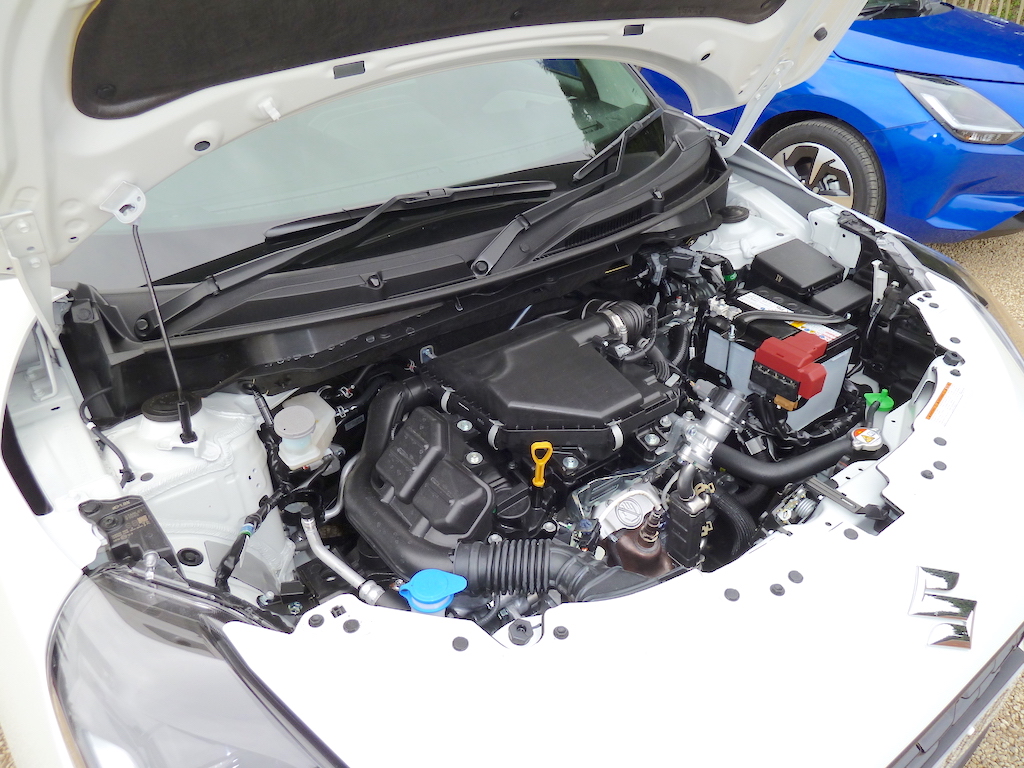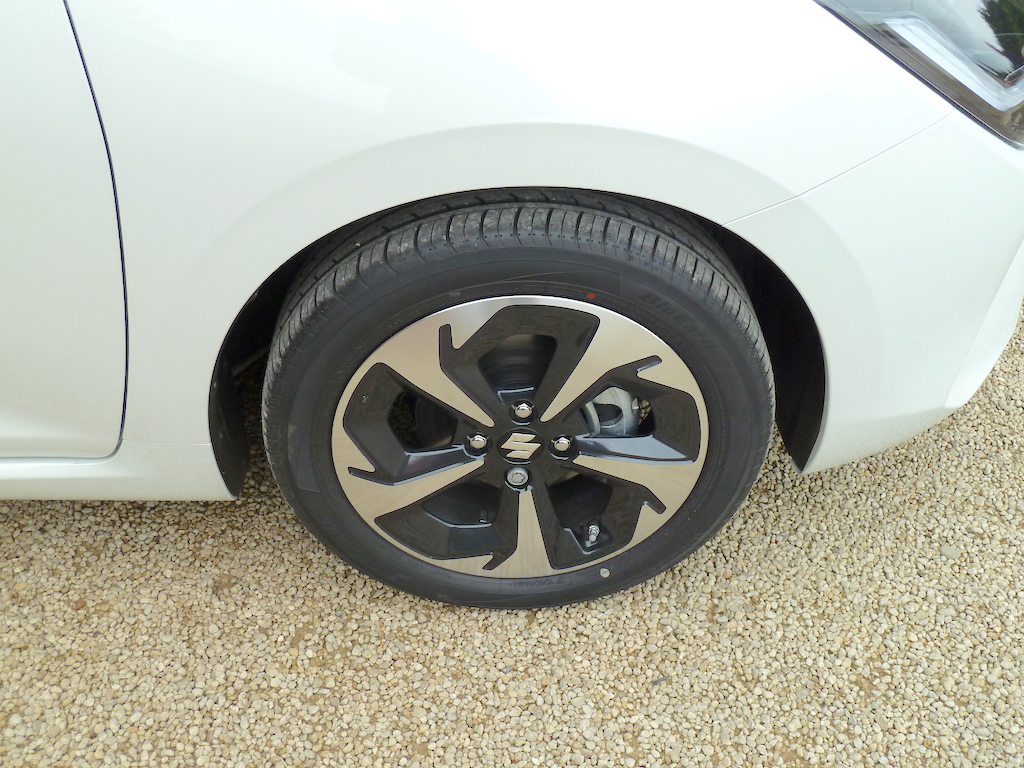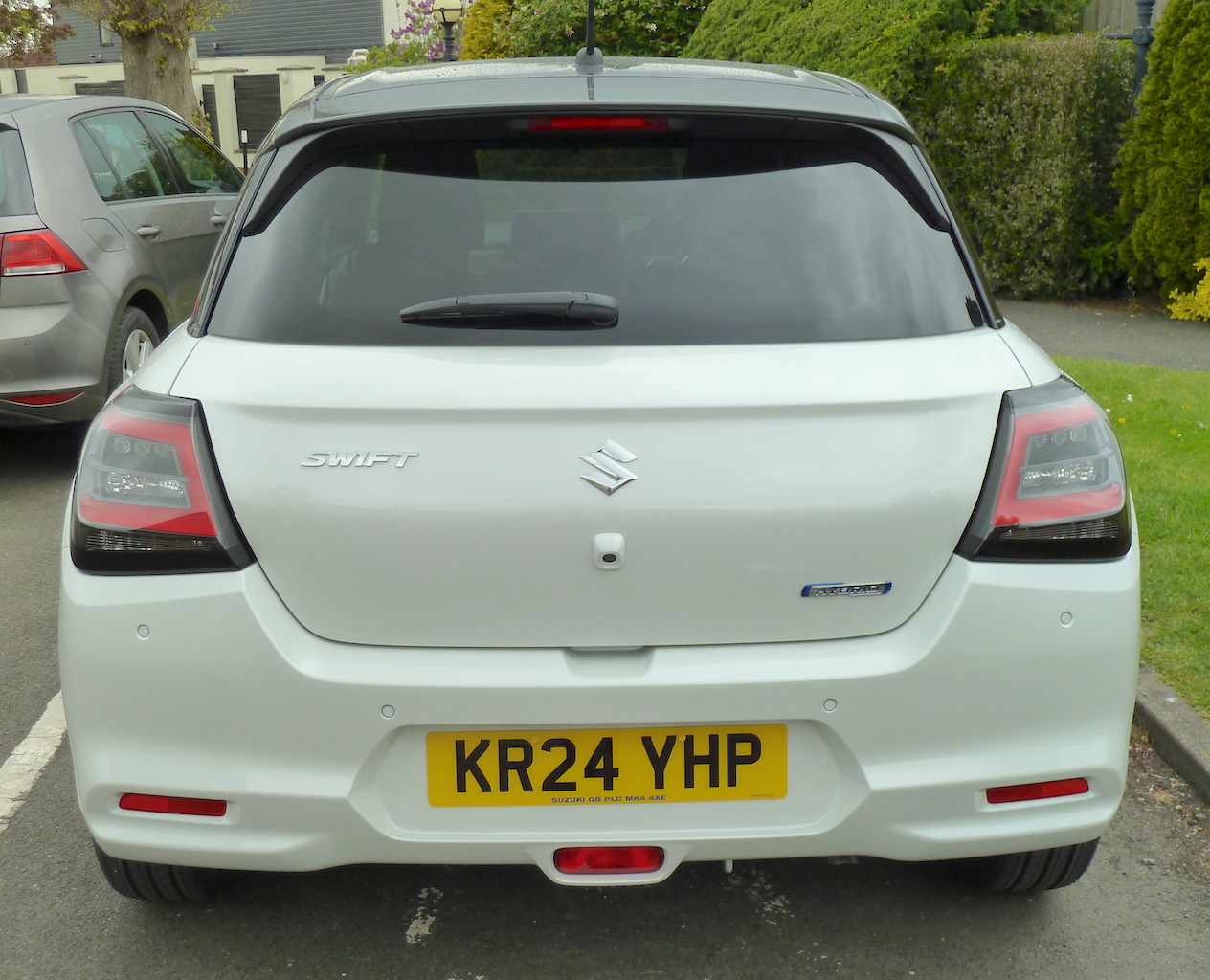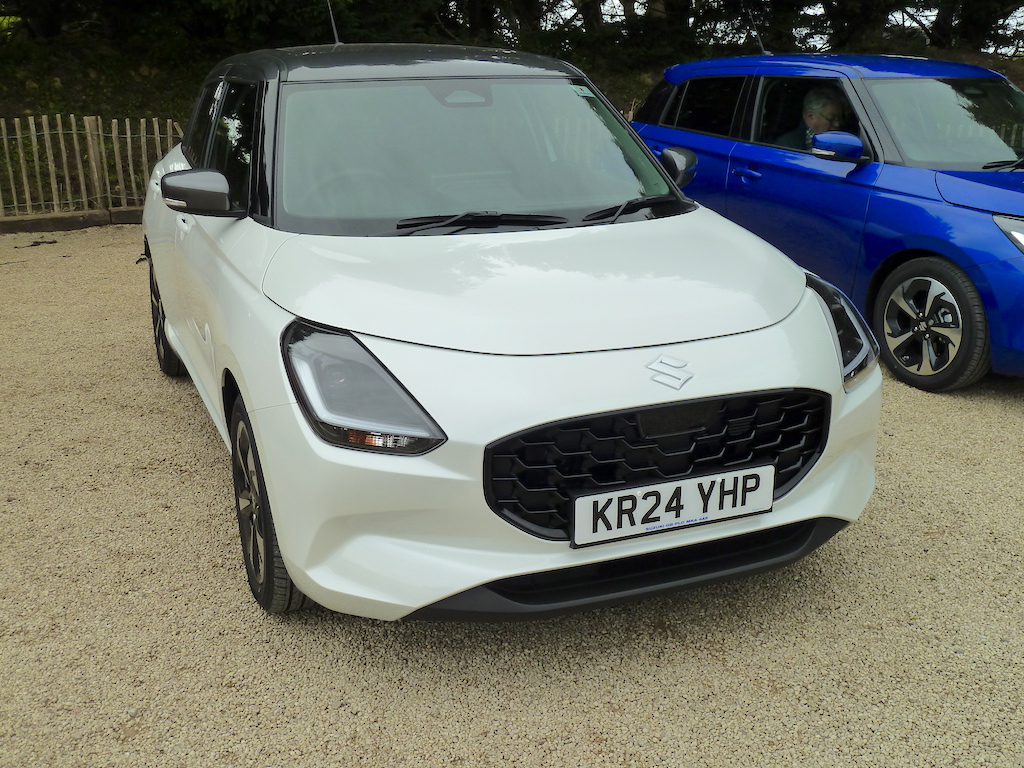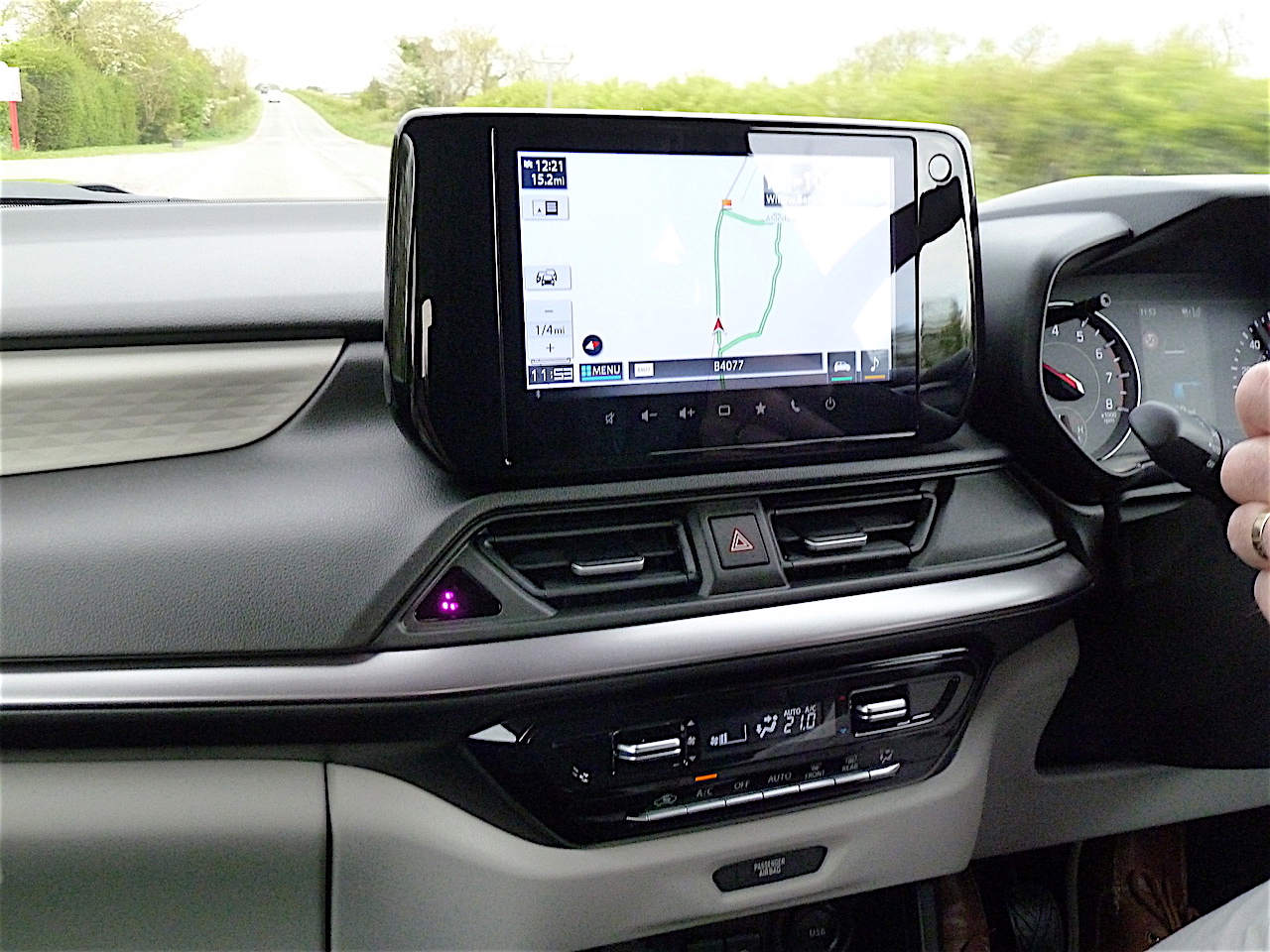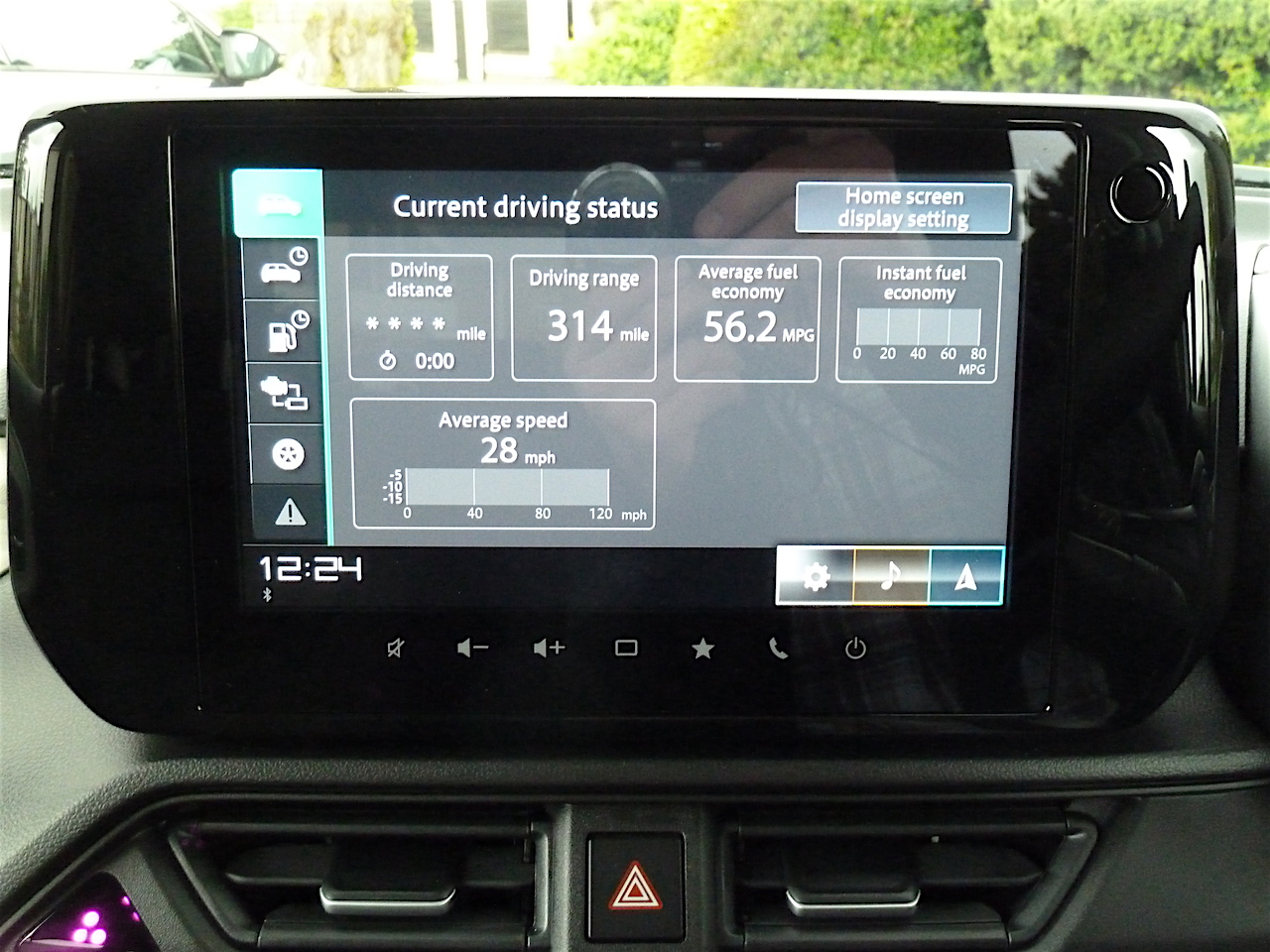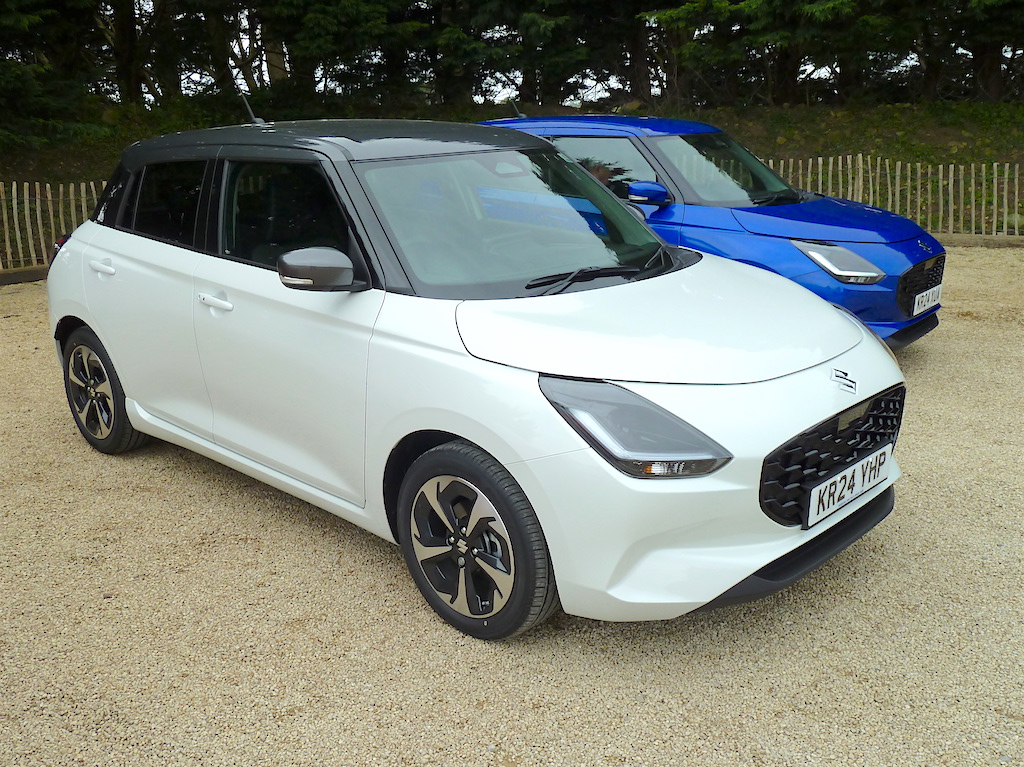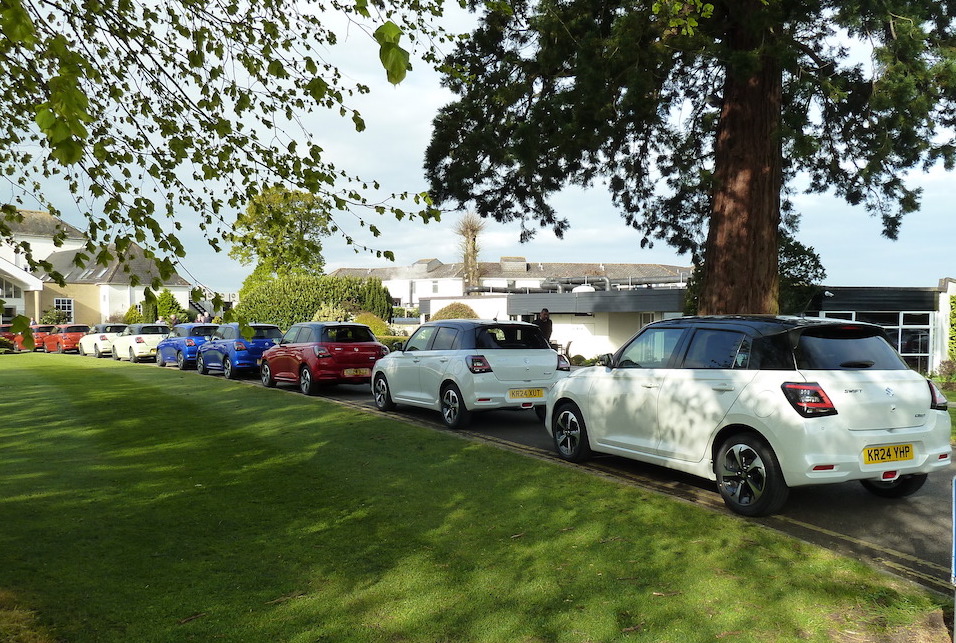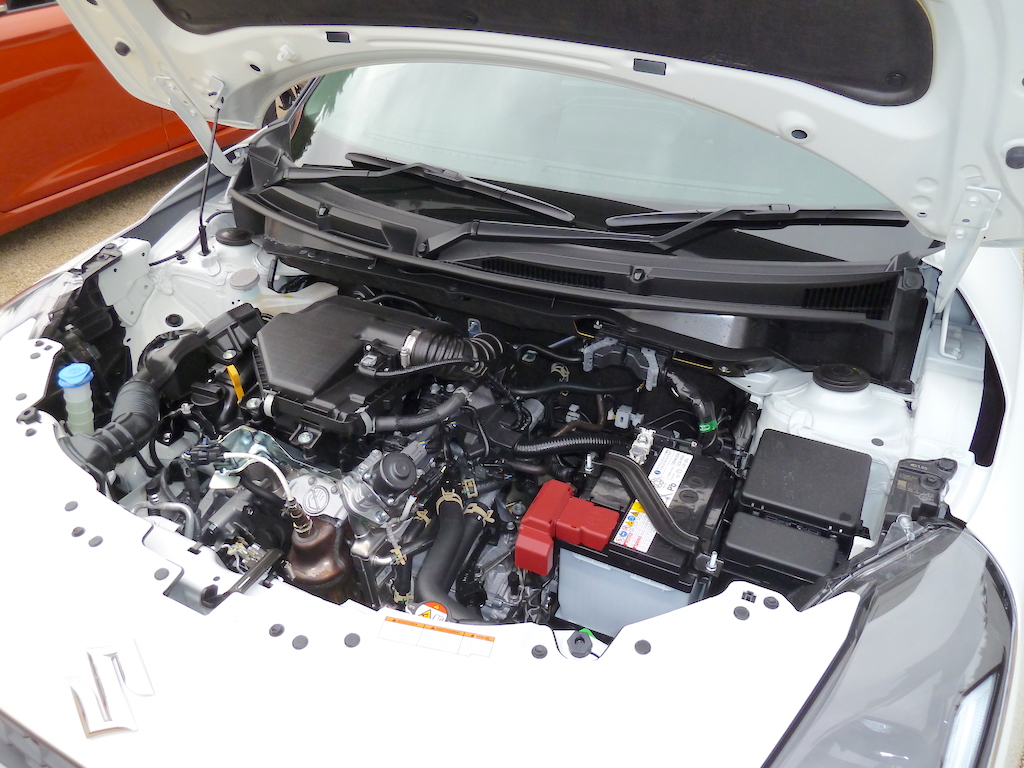Kim Henson samples the latest, Fourth Generation of Suzuki’s compact supermini, the Swift.
(Images and words by, and copyright, Kim Henson).
Suzuki’s Swift has been impressing owners over the last 40 years and three generations, with more than nine million examples having been sold globally, across 119 countries.
As with all Suzukis, the model has earned a justifiable reputation for long-term dependability and practicality.
In researching for this article I have been fascinated to look at, and read about, the previous generations of Swift models, all ‘state of the art’ for their time and all good, well-engineered cars. Many of the older generation models are still providing dependable, cost-effective service for their owners, after many years of use. They have an excellent reputation among owners and within the motor trade.
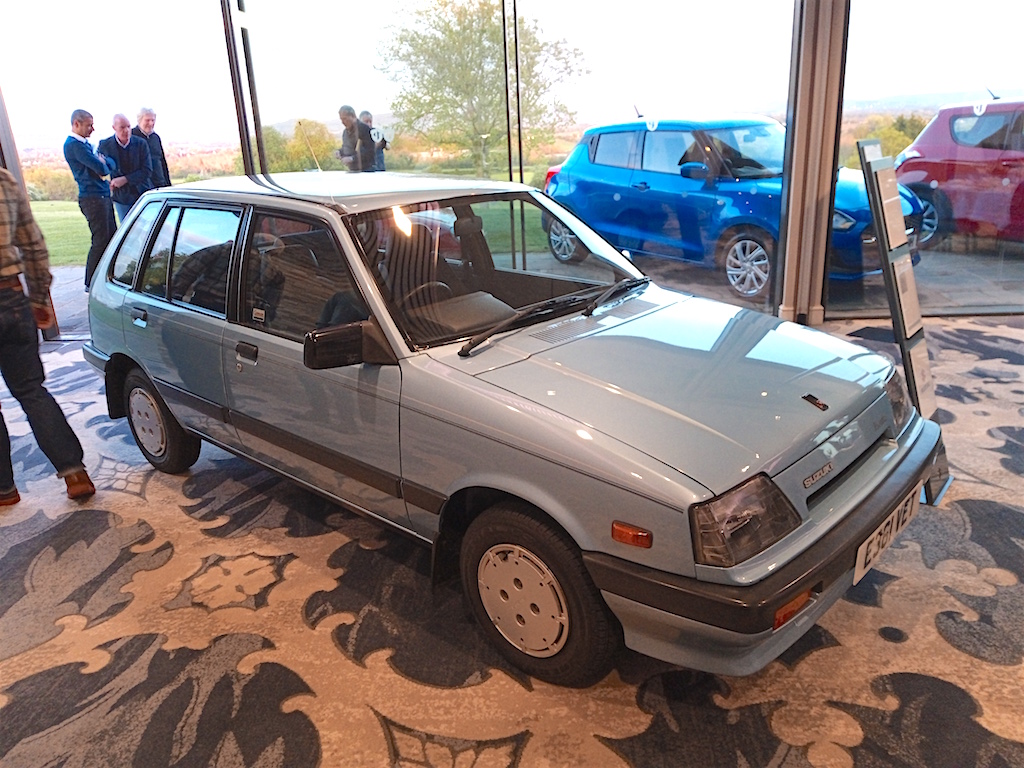
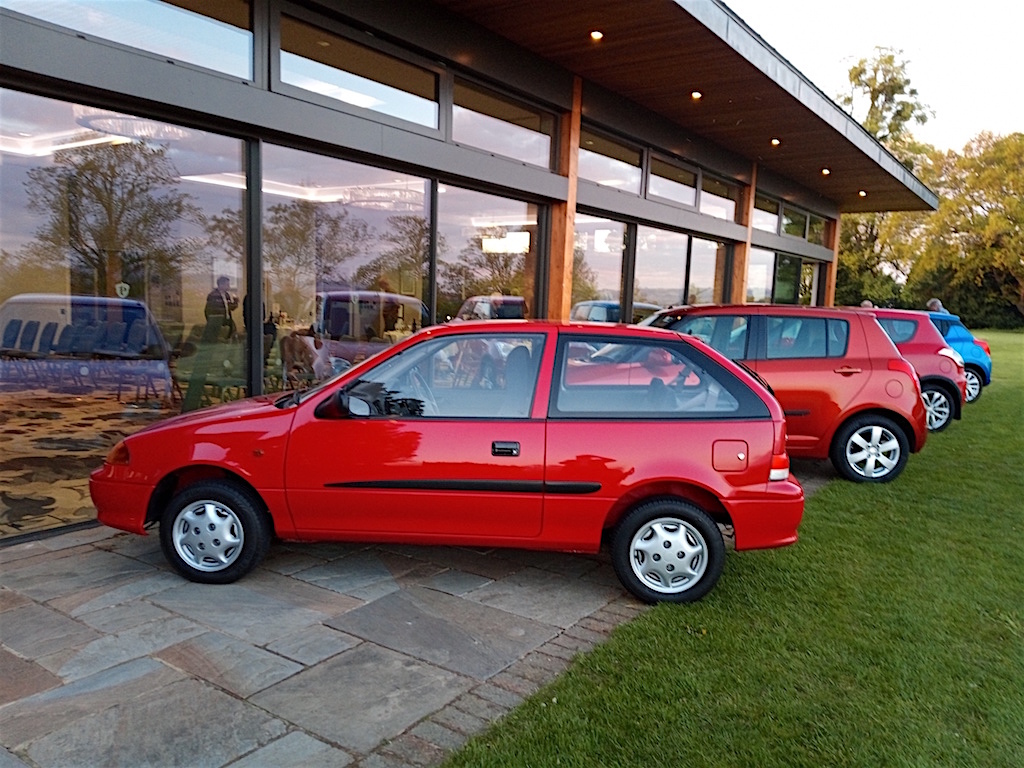
The latest range has arrived, and from April 2024 is already on sale in the U.K. and the Republic of Ireland; Swifts sold in these markets and across Europe are built in Suzuki’s Sagara plant in Japan. The newcomer had first been showcased, in Swift Concept form, at the Japan Mobility Show in Tokyo, in October 2023.
I recently attended the U.K. launch of the latest model, and before looking in detail at the new car, it is worth setting the scene with a little context, as explained by the Suzuki U.K. team to the motoring writers present…
Suzuki has been making significant year on year gains in terms of global sales, including in Europe and in India, where the firm’s car sales already account for a market share approaching 50 per cent. India provides a vital market for vehicle sales, and is poised to become bigger still in this regard; it may soon become the second or third largest market in the world.
It is notable that the ‘Net Zero’ emissions targets for Europe and Japan stand have been set for 2050, whereas for India the target date is 2070 (although things may change of course!).
Suzuki is adopting a multi-faceted approach in reducing emissions and dependence on fossil-based fuels, including the exploration and development of fully–electric vehicles, hybrid electric models, those running on CNG (Compressed Natural Gas) and those using biofuels. The company’s first fully electric vehicle is due to arrive here in 2025, and it is interesting that between 2023 and 2030 the firm is planning to spend some £12.4 billion on electrification.
That said, Suzuki is finding that at the moment, most mainstream retail car buyers still prefer cars with Internal Combustion Engines (ICEs), with market figures showing that just 15 per cent of cars sold are fully electric vehicles.
The company says too that there are now fewer small car choices for supermini customers, as some competitor manufacturers are moving away from ICE power and are producing larger numbers of SUVs, rather than compact cars.
Many of the small car models on the market today are electrically-propelled, yet many retail buyers of superminis will not compromise and want their next vehicle still to be ICE powered. It is believed that this therefore presents Suzuki with sales opportunities for the new hybrid Swift, for such buyers.
This optimism is reflected in sales figure forecasts for the new Swift model… The outgoing Swift is selling at the rate of around 9,400 vehicles per year (putting the car at 15th in its sales league sector), whereas forecasts/ambitions for the new generation model are running at approximately 12,000 units annually, which would take the car into the sales chart top 10.
I should mention too that in order to encourage interest in the new Swift, zero per cent finance is being offered until the end of June 2024, for PCP/HP arrangements. Example figures work out at:
For a Motion version with manual transmission, £3,972 deposit plus payments of £189 per month.
For a Motion with CVT auto transmission, £4,179 deposit and then £159 per month.
The all-new Swift
The exterior and interior designs of the new model look familiar, but have been amended in positive and subtle respects, and standard equipment levels have been further enhanced (they were already comprehensive).
Among the main external styling changes are ‘blacked-out’ roof pillars (giving the impression of a ‘floating’ roof), a new, piano-black front grille, and L-shaped lamps, also rear hatch and boot side spoilers.
The revised LED headlamps feature an inner lens and light rod set-up, providing a wider appearance when illuminated. Rear combination lamps are of the same design type as those at the front of the vehicle, and when the rear lamps are lit up, they take on a three-dimensional appearance.
Within the car, a fresh two-tone approach has been used, including the incorporation of high quality materials and with the centrally-positioned controls angled towards the driver. There’s a new standard-fit nine-inch central infotainment display too, with a built-in navigation system, and all versions come with heated front seats (with revised bolsters and head restraints) – all these features are part of the standard specification for all new Swifts.
A geometric pattern upholstery material (‘Melange Grey’ and black cloth) is used in both the Motion and Ultra models.
Notable underbonnet changes have resulted in a Swift that provides greater torque, better performance (acceleration to 62 mph from rest is 5 per cent quicker, at 12.5 seconds for the manual versions, 11.9 seconds for CVT variants), improved fuel consumption and lower CO2 emissions.
Suzuki’s new Z12E Mild Hybrid 1.2 litre three cylinder engine (with its enhanced, lightweight 12 volt Mild Hybrid system is fitted as standard) develops 82 PS and 112 Nm (83 lb.ft) of torque, emits just 99 g/km CO2, and provides fuel consumption up to eight per cent better than the previous K12D motor. The new Combined consumption figure is 64.2 miles per gallon for the manual transmission Motion version. Suzuki says that the new car offers class-leading Combined mpg figures.
Consumption improvements (compared with the previous K12D motor) are said to have been achieved by optimising cylinder turbulence for more rapid combustion, incorporating an intermediate locking mechanism in the Variable Valve Timing (VVT) intake, and increasing the flow rate of the Exhaust Gas Recirculation (EGR) valve.
Further gains in fuel consumption have been achieved by the new engine being linked with Suzuki’s standard-fit enhanced light-in-weight 12 volt self-charging Mild Hybrid system, which employs a 10 Ah lithium-ion battery to improve energy recovery efficiency.
The system takes the form of a compact and light-in-weight (under 7 kg or 15 lb) belt-driven unit termed an ‘Integrated Starter Generator’ (ISG), which operates both as a starter motor and generator. It assists the petrol engine during start off and acceleration, as well as generating electricity through regenerative braking. Its power output is 2.3 kW and torque figure 60 Nm (44 lb.ft).
There is a built-in ‘stop-start’ facility that cuts the engine when the car is stopped at traffic lights (for example). The belt drive helps to ensure smooth restarting after an automatic engine stop.
The lightweight lithium-ion battery is said to have excellent regenerative efficiency, thereby increasing the frequency of engine assists. This battery supplies power to the engine, instruments and audio system as well as the Mild Hybrid system.
Further important details within the engine design include a new coolant water jacket to optimise temperature control, and aided by cylinder cooling jets, effectively eliminating any detonation despite the high compression ratio of 13.9:1, for high combustion efficiency.
Additional gains in this area have been achieved by fitting a pendulum type auxiliary drive belt tensioner, and an electric water pump that maintains coolant flow, whatever the engine speed.
Particulate Number (PN) emissions are minimised by the use of a high porosity three-way catalytic converter and petrol particulate filter termed a Gasoline Particulate Filter (GPF). These deal with incomplete combustion that can arise with higher compression ratios.
Drive is delivered to the front wheels through a five speed manual gearbox or optionally available CVT (Constantly Variable Transmission) automatic transmission – which still enables a creditable Combined fuel consumption figure of 60.1 miles per gallon to be achieved.
The revised five speed manual gearbox has been developed with ratios specifically optimised for the new three cylinder engine, with revisions also made to the synchromesh, gear lever ratio and the lever assembly’s spring rate, to improve gearchange operation and precision.
On CVT versions, the fully automatic electrically-controlled transaxle incorporates a two-stage planetary gear unit and single speed reverse gear. The use of the planetary gear set-up enables the gear ratio ranges to be expanded to provide good response during acceleration and quieter running at higher speeds. It is interesting that the standing start acceleration figures for the CVT transmission versions are more rapid than those for the manual gearbox cars.
The CVT unit’s torque converter is a three element, single step, two phase type, and features an automatically-controlled lock-up mechanism.
The gearchange set-up provides seven ‘step gear’ programmes and comprises a planetary gear unit, multiple disc type clutch, multiple disc type brake, a steel belt, plus primary and secondary pulleys. On the Ultra version (optionally) fitted with the CVT transmission, the gear programmes can also be selected manually by use of steering column mounted ‘paddles’.
Later in 2024 optional ALLGRIP ‘Auto’ 4WD will be available on Ultra models with manual transmission. It is interesting that Suzuki provides this option on their supermini, and it is very useful for buyers such as country district dwellers requiring the reassurance of all wheel drive, without the need for a specific (and often larger) four wheel drive vehicle.
The new Swift has (deliberately) been built within the same dimensions as the outgoing model, emphasising Suzuki’s prowess in producing compact vehicles. The car is just 3.86 metres (12.66 ft) long, and is built on Suzuki’s well-respected ‘HEARTECT’ platform (more of which anon), with a kerb weight of just 949 kg (2,092 lb) for the Motion version fitted with a manual gearbox.
Suspension steering and brakes
Tweaks to the existing effective running gear have been made for the new Swift, and these include the adoption of a thicker front anti-roll bar, plus the inclusion of Teflon sheets in the stabiliser mounts, to increase roll rigidity by reducing friction, thereby improving steering feel and enhancing handling stability.
On two wheel drive versions, the rear suspension stroke has been increased to enable the rear wheels to better follow the rise and fall in road surfaces. In addition, revised suspension bump stops have been fitted to improve comfort for all occupants.
Changes to the Electric Power Steering (EPS) system have been made to result in better steering feel, a more linear steering response, and a smoother self-centre action on poor road surfaces.
Amendments to the brake servo unit have been carried out to provide a smoother, more linear braking response.
There’s a straightforward two model line-up, with ‘Motion’ and ‘Ultra’ grades…
The Motion model, priced from £18,699, will be the volume-seller in the range, and its standard specification includes a rear upper spoiler, LED headlamps, 16 inch aluminium alloy road wheels, a nine-inch media display including Apple CarPlay and Android Auto connectivity, Navigation, Adaptive Cruise Control, heated front seats, a rear view camera, rear parking sensors, upgraded Dual Sensor Brake Support, enhanced Traffic Sign Recognition and Blind Spot Monitor, plus keyless entry and start, Driver Monitoring System, Lane Departure Warning and Weaving Alert, plus Rear Cross Traffic Alert.
The latest Swift’s safety systems are as sophisticated as they are comprehensive, and include an enhanced Dual Sensor Brake Support System that now uses millimetre-wave radar (previously lidar), combined with a monocular camera. This system provides better collision mitigation plus improved visibility at night, in poor weather conditions and at intersections.
The Driver Monitoring System employs a camera (built onto the instrument panel), that monitors the driver’s eyes. If it senses that the driver is drowsy or losing concentration it sounds an alarm and displays a warning message on the dash.
Moving up to the Ultra specification, costing from £19,799, buyers additionally gain 16 inch polished aluminium alloy wheels, automatic air conditioning, a heater outlet for rear seat occupants, plus electric folding door mirrors, with built-in repeater turn signals.
The optionally available (on both models) CVT transmission on both models costs an additional £1,250.
On all new Swifts Suzuki Connect connected services are provided free of charge for three years from registration date. These use the car’s Data Communication Module (DCM) and are accessed via a smartphone app. They provide users with a variety of vehicle-related information.
Suzuki’s popular Service Activated Warranty is also offered free of charge after the company’s warranty expires and until the car reaches up to seven years/100,000 miles.
Looking closely
As mentioned, the basis for the new Swift is Suzuki’s proven ‘HEARTECT’ platform, developed to be both light in weight and rigid. The much-revised frame for the new car is said to provide enhanced collision safety and has a continuous, smooth, curving form, to help more quickly disperse energy. The use of this latest generation of the platform has enabled the company to minimise the required size of the engine compartment, thus releasing/maximising available space for passengers and luggage.
A variety of measures have been taken during development of the new car to reduce ‘NVH’ (Noise, Vibration and Harshness) intrusion. Among these, the new body shell incorporates underbody sound and vibration adhesive, to reduce the transmission of noise and vibration into the car. Structural adhesive has also been applied to the upper body.
In addition, ‘A’ pillar sound baffle plates have been increased in number from two to four, damping panels have been fitted to the floor and dashboard areas, and a heavier grade carpet has been used.
Together, these measures are intended to improve comfort overall, especially when driving on less than smooth surfaces.
A further mechanical innovation has been the development of liquid-filled engine mountings, to minimise vibration when the engine is idling and driving.
Aerodynamic improvements around the vehicle include underbody spoiler and strakes, a torsion beam cover (Suzuki’s first use of this), a smooth finish front bumper, plus external rear bodywork spoilers.
In addition, the new road wheels are optimised for aerodynamic performance (in this regard the wheel cut-outs are smaller and there’s a disc-shaped outer rim), and the tyres used provide 15 per cent less rolling resistance than those on the outgoing Swift.
Exterior paintwork for the newcomer is available in a choice of eight metallic colours, plus four two-tone arrangements, including the roof painted in either Black Pearl or Grey metallic, depending on the colour scheme chosen.
In the case of the Frontier Blue and Burning Red Pearl Metallic shades, they are given a very vivid depth of colour, thanks to a new three layer process. After electroplating of the bare metal body shell, and the application of primer, a base colour coat is applied, followed by a coat of clear lacquer, then topped by an additional lacquer coat.
Notably, the only colour available within the quoted vehicle price (i.e. without an additional premium payable), is Flame Orange Pearl Metallic. For all other shades, an extra £500 to £700 is payable for single colours (depending on the chosen colour), or £850 for dual tone finishes.
Suzuki’s Chief Engineer, Masao Kobori comments “The Swift has always been designed to be fun to drive, and the new car is no exception. But in order to respond to peoples diversifying lifestyles, we focused not just on design and driving which have always been Swift strengths – but also on making every aspect of daily life with a Swift more exciting and satisfying. That was the concept that guided our development from the start.“
Outgoing Swift…
Before trying, and writing about, the latest generation Swift, recently I was given the opportunity of driving one of the last of the outgoing Swifts, for comparison. In fact on Wheels-Alive we have been assessing the various Swift models over the last decade or so, and all these have impressed, in their time, in terms of everyday practicality, very respectable performance plus frugal fuel consumption and low emissions. In addition we know, from real world feedback from owners as well as trade contacts, that Swifts, as with Suzukis generally, are reliable, cost-effective and durable in use. This has been backed up repeatedly by impartial ownership surveys over the years.
It was therefore with interest that I was re-acquainted with the outgoing Swift model, during a brief test drive on country district roads in north Wiltshire. I found that I still liked the seat comfort, the driving position, the clarity of the instrumentation, the ride quality and overall good performance of this car, and to me it still has the look and feel of a well-designed, high quality compact machine. So how would the newcomer compare?
New Swift test drive
On the occasion of the model’s U.K. launch I was able to test drive the latest generation Swift during a morning over a variety of roads, including main through-routes, winding B roads and by-ways, some of which included broken tarmac and potholes.
The test vehicle was an Ultra version with Suzuki’s manual five speed gearbox. The On The Road price for this model is £19,799, to which £750 needs to be added for the optional dual tone paint finish.
The main body colour of the car I was driving was Pure White Pearl Metallic, with a Mineral Grey roof, and very smart it looked, I felt. I closely inspected the paintwork of other Swifts on the launch too, and was impressed by the impeccable finish found on them all, notably including those finished in the very special Burning Red Pearl Metallic and Frontier Blue Pearl Metallic colours. Indeed the quality of the paint finish was truly superb.
The revised interior within the new Swift looked and felt high quality, with comfortable seating plus good head and leg room for both front and rear seat occupants (rear seat leg room seemed pretty good for a supermini, even with the front seats set towards the rearwards extent of their travel). While talking of space, the luggage compartment, accessed from bumper height, is spacious for a supermini and the available platform can be greatly extended when required, by folding the 2/3:1/3 divided rear seats (please see our data section for volume figures).
The newcomer has a smart and effective facia layout. I liked the central touch screen, with separate heating/ventilation controls located beneath the screen – good for safety I feel, and I was also appreciative of the crystal-clear instrumentation and way that the centrally-located controls were angled towards the driver.
On the Road
Now I have always thought that the previous Swift was good in terms of refinement but straight away it was clear to me that the new car has moved up a league in this respect. The engine was smooth-running and hushed, from idle speed and even when accelerating hard. In this situation it was just possible to detect the unique sound identifying a three cylinder motor, but this was pleasant and in no way intrusive.
I also found the car to be lively in acceleration, both from rest and on the move, and the revised gearchange was a delight to use – smooth and rapid between ratios.
Cruising at higher speeds on the open roads was very quiet too, and the gem of a motor was always eager to pull strongly when required, even from low engine speeds.
Notable to me was the way in which the car rode smoothly and quietly over all surface imperfections, without transmitting the suspension’s motion harshly to the interior. I thought that the ride quality was excellent for a compact vehicle.
I also found that the steering feel was commendable at all speeds – light when carrying out low speed manouvres yet responsive and positive at higher speeds.
Overall ride and handling qualities were first class, in my opinion.
Fuel consumption during my test drive worked out at 56.2 miles per gallon, according to the on-board computer, but this included some spirited driving at times and I am confident that the quoted Combined figure of 64.2 mpg is easily achievable in normal use. Indeed, one of the test Swifts recorded better than 70 miles per gallon when covering the same route.
I should add… I am a big fan of Suzuki’s approach in having a straightforward specification list for each of their models, including the Swift, with the only extra cost options being paint colours. Buyer choice is between the two versions, Motion and Ultra, and of course transmission types. In other respects everything is incorporated within the equipment list and there is no need to add extra cost items to build a comprehensive specification, as is the case with so many competitor models that consequently can cost considerably more in total, than their initial pricing suggests!
VERDICT
Well done Suzuki!
I have long rated the previous generation Swift as a likeable, high quality supermini; the new model is better still, in so many ways, and I feel that it represents good value for money, especially when the comprehensive levels of standard specification are considered.
Am I being too generous in my praise? I don’t think so, for all my fellow motoring writers that I spoke to after driving the Swift were of a similar positive opinion.
We hope to bring you a full road test in due course; please watch this space!
WHEELS-ALIVE TECH. SPEC IN BRIEF:
Suzuki Swift five door supermini hatchback
Engine: Three cylinder, 12 valve 1.2 litre (1197cc), Euro 6D petrol, multipoint fuel injection
Transmission: Five speed manual gearbox (CVT option); front wheel drive (optional 4WD from late 2024).
Power: 82 PS @ 5,750 rpm.
Torque: 112 Nm (83 lb.ft) @ 4,500 rpm.
Performance (with manual transmission):
0 – 62 mph: 12.5 seconds.
Top speed: 103 mph.
Fuel consumption (with manual transmission):
Official Combined (WLTP), 64.4 mpg.
On a brief test, average 56.2 mpg.
CO2 Emissions (WLTP): 99 g/km (WLTP figure)
Warranty: Three years/60,000 miles, plus One Year AA Suzuki Assistance, plus 12 years warranty against perforation.
Note: Suzuki’s Service Activated Warranty is also offered free of charge after the company’s three year warranty expires, and until the car reaches up to seven years/100,000 miles (whichever comes first). Cars serviced by a Suzuki dealer are covered by complimentary warranty (which covers major components) until the next scheduled service. Fresh cover is provided on each occasion when a scheduled service takes place, up to the age/mileage limit.
(This applies to Suzukis up to seven years old, even those without a full service history, or those purchased privately. It is transferable to a new owner if the car changes hands within the seven year qualifying period).
Dimensions:
Length: 3,860 mm (12.66 ft)
Width: 1,735 mm (5.69 ft)
Height, 2WD: 1,495 mm (4.90 ft)
Height, 4WD 1,520 mm (4.99 ft)
Wheelbase: 2,450 mm (8.04 ft)
Turning circle (min.). 9.6 metres (31.5 ft)
Wheels and tyres: 16 inch aluminium alloy wheels, shod with 185/55R16 tyres
Luggage capacity (VDA):
Seatback raised, 265 litres (9.36 cu.ft)
Seatback folded, 589 litres (20.80 cu.ft.)
Kerb weight inc. full options: 949 kg (2,092 lb.)
Max. braked towing weight: 1,000 kg (2,204 lb.)
Price (‘On the Road’):
Motion: From £18,699
Ultra: From £19,799
CVT transmission: Add £1,250
Alternative paint colours: Please see text.
My Ultra test vehicle: £19,799 plus £750 for the white/grey dual tone paint finish, making £20,549 in total.
